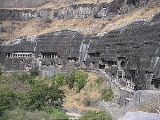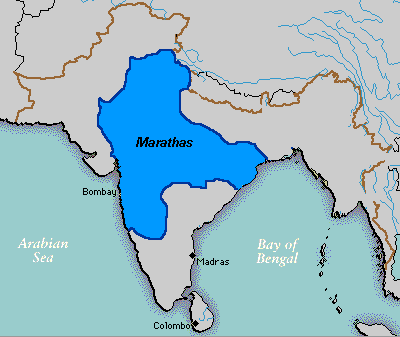
History of Maharashtra
Encyclopedia
The antiquity of this region can be traced to approximately the 3rd century BC. Marathi, which evolved from Maharastri-Prakrit, has been the lingua franca of the people of this area from the 10th century onwards. The oldest stone inscriptions in Marathi language can be seen at Sravanbelagola in Karnataka at the foot of the Bahubali Statue (Jain). And, in the course of time, the term 'Maharashtra' was used to describe a region which consisted of Aparanta
, Vidarbha
, Mulak, Ashmak and Kuntal. The tribal communities of Nags, Munds and Bhills inhabited this area, also known as Dandakaranya
, in ancient times. They were joined by the Aryas, the Shakas and the Huns
, who came from the North, as well as by foreigners, who arrived by sea.
 The Marathas dominated the political scene in Maharashtra from the middle of the 17th century to the early 19th century. Although for historical purposes the term 'Maratha' is used in a comprehensive sense to include all Marathi-speaking people, actually the word signifies the distinct community which has dominated the political scene of Maharashtra since medieval times.
The Marathas dominated the political scene in Maharashtra from the middle of the 17th century to the early 19th century. Although for historical purposes the term 'Maratha' is used in a comprehensive sense to include all Marathi-speaking people, actually the word signifies the distinct community which has dominated the political scene of Maharashtra since medieval times.
References to the Marathas and their country are found in accounts by the Arab geographer, Al Biruni (1030 AD), Friar Jordanus
(c. 1326) and Ibn Batuta (1340), the African traveller. The Marathas came into political prominence only in the 17th century under Shivaji.
Shivaji is well known for his fatherly attitude towards his subjects. He believed that the state belonged to the people. He encouraged all socio-economic groups to participate in the ongoing political changes. To this day he is remembered as a just and welfare-minded king. He brought revolutionary changes in military, fort architecture, society and politics.
Because of his struggle against an imperial power, Shivaji became an icon of freedom fighters (along with the Rani of Jhansi) in the Indian independence struggle that followed two centuries later. He is remembered as a just and wise king and his rule is called one of the six golden pages in Indian history.
School texts in Maharashtra glorify Shivaji's period and he is considered the founder of the modern Marathi nation; his policies were instrumental in forging a distinct Maharashtrian identity. Indeed, Marathi Hindus, Dalits, Muslims, Christians and Buddhists, all consider him as a hero. A popular quotation,
translates as, "Bring as many people into Maratha domain as possible and grow the Maharashtra Nation".
The ultimatum to the British to "Quit India" was given in Mumbai, and culminated in the transfer of power and the independence of India in 1947. Raosaheb and Achutrao Patwardhan, Nanasaheb Gore, SM Joshi, Yeshwantrao Chavan,Swami Ramanand Bharti,Nana Patil,Dhulappa Navale,V.S.Page, Vasant Patil,Dhondiram Mali and several others played a prominent role in this struggle. BG Kher was the first Chief Minister of the tri-lingual Bombay Presidency.
Other revolutionaries from Maharashtra:
Shivaram Rajguru
, Vishwanath Vaishampayan, Ganesh Damodar Savarkar
, Dattatray Balwant Karandikar, Dnyaneshwar Deshpande, Gajananrao Potdar, Shriram Balwant Savargaokar, Vasudev Balwand Phadke, Chapekar brothers
Aparanta
Aparanta, or Aparantaka was a geographical region of ancient India, variously corresponding to the northern Konkan, northern Gujarat, Kathiawar, Kachch and Sindh....
, Vidarbha
Vidarbha
Vidarbha is the eastern region of Maharashtra state made up of Nagpur Division and Amravati Division. Its former name is Berar . It occupies 31.6% of total area and holds 21.3% of total population of Maharashtra...
, Mulak, Ashmak and Kuntal. The tribal communities of Nags, Munds and Bhills inhabited this area, also known as Dandakaranya
Dandakaranya
Dandakaranya is a spiritually significant region in India. It is roughly equivalent to the Bastar District in the central east part of India...
, in ancient times. They were joined by the Aryas, the Shakas and the Huns
Huns
The Huns were a group of nomadic people who, appearing from east of the Volga River, migrated into Europe c. AD 370 and established the vast Hunnic Empire there. Since de Guignes linked them with the Xiongnu, who had been northern neighbours of China 300 years prior to the emergence of the Huns,...
, who came from the North, as well as by foreigners, who arrived by sea.
The Marathas

References to the Marathas and their country are found in accounts by the Arab geographer, Al Biruni (1030 AD), Friar Jordanus
Jordanus
Jordanus or Jordan Catalani was a French Dominican missionary and explorer in Asia known for his Mirabilia describing the marvels of the East.-Travels:He was perhaps born at Sévérac-le-Château in Aveyron, north-east of Toulouse...
(c. 1326) and Ibn Batuta (1340), the African traveller. The Marathas came into political prominence only in the 17th century under Shivaji.
Chhatrapati Shivaji
Shivaji was an able administrator and established a government that included such modern concepts as cabinet (Ashtapradhan mandal), foreign affairs (Dabir) and internal intelligence. Shivaji established an effective civil and military administration. He also built a powerful navy and erected new forts like Sindhudurg and strengthened old ones like Vijayadurg on the west coast. The Maratha navy held its own against the British, Portuguese and Dutch till Maratha internal conflict brought their downfall in 1756.Shivaji is well known for his fatherly attitude towards his subjects. He believed that the state belonged to the people. He encouraged all socio-economic groups to participate in the ongoing political changes. To this day he is remembered as a just and welfare-minded king. He brought revolutionary changes in military, fort architecture, society and politics.
Because of his struggle against an imperial power, Shivaji became an icon of freedom fighters (along with the Rani of Jhansi) in the Indian independence struggle that followed two centuries later. He is remembered as a just and wise king and his rule is called one of the six golden pages in Indian history.
School texts in Maharashtra glorify Shivaji's period and he is considered the founder of the modern Marathi nation; his policies were instrumental in forging a distinct Maharashtrian identity. Indeed, Marathi Hindus, Dalits, Muslims, Christians and Buddhists, all consider him as a hero. A popular quotation,
"Maratha tituka milavava
Maharashtra Dharma vadhavava"
translates as, "Bring as many people into Maratha domain as possible and grow the Maharashtra Nation".
Maharashtra's role in the freedom movement
Dr. Bhimrao Ramji Ambedkar, the first Law Minister of India,an erudite scholar with a number of doctorates, and a Barrister, championed the cause of Depressed Classes of India, the lower caste population who were oppressed for centuries. Dr. Ambedkar disagreed with mainstream leaders like Gandhi on issues including untouchability, form of government and Partition of India. This did not prevent him from struggling for the rights of his brethren among the lower castes of the country. His leadership of Dalit or Depressed Classes, lead to the Dalit movement that still endures.The ultimatum to the British to "Quit India" was given in Mumbai, and culminated in the transfer of power and the independence of India in 1947. Raosaheb and Achutrao Patwardhan, Nanasaheb Gore, SM Joshi, Yeshwantrao Chavan,Swami Ramanand Bharti,Nana Patil,Dhulappa Navale,V.S.Page, Vasant Patil,Dhondiram Mali and several others played a prominent role in this struggle. BG Kher was the first Chief Minister of the tri-lingual Bombay Presidency.
Other revolutionaries from Maharashtra:
Shivaram Rajguru
Shivaram Rajguru
Shivaram Hari Rajguru was an Indian revolutionist from Maharashtra and belonged to the Deshastha Brahmin community. Rajguru was born in a place named Khed near Pune. It was later renamed as Rajgurunagar in his honor. He is best known as a colleague of Bhagat Singh and Sukhdev in the murder of a...
, Vishwanath Vaishampayan, Ganesh Damodar Savarkar
Ganesh Damodar Savarkar
Ganesh Dāmodar Sāvarkar was an Indian freedom fighter, Hinduist Rightist, a revolutionary, and founder of the Abhinav Bharat Society....
, Dattatray Balwant Karandikar, Dnyaneshwar Deshpande, Gajananrao Potdar, Shriram Balwant Savargaokar, Vasudev Balwand Phadke, Chapekar brothers
Chapekar brothers
The Chapekar brothers alternatively spelt as Caphekar or Chaphekar , Damodar Hari, Balkrishna Hari and Vasudeo Hari belonged to Chinchwad, then a village, near the former Peshwa capital Pune, in the state of Maharashtra, India.In late 1896, Pune was hit by bubonic plague; by the end of February...

